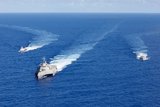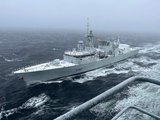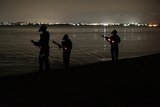Teledyne Wins $6.2M ($52.6M with Options) U.S. Navy Glider Contract
Teledyne Technologies Incorporated announced today that its subsidiary, Teledyne Brown Engineering, Inc. (TBE), of Huntsville, Ala., has been awarded a contract to design, engineer, build, test and deliver ocean Littoral Battlespace Sensing-Gliders (LBS-G), as well as associated support equipment.
The contract was awarded by the Space and Naval Warfare Systems Command on behalf of the Navy's Program Executive Office for C4I. The initial cost plus incentive fee contract is valued at $6.2 million. If all options are exercised, the contract would be valued at an estimated $52.6 million. The initial contract is expected to be completed by July 2010 (November 2014 with options exercised).
The Navy plans to use fleets of gliders with their relative low cost, minimal power usage and longevity at sea to acquire critical oceanographic data to improve positioning of fleets during naval maneuvers.
"This contract is a result of combining the strengths of multiple Teledyne businesses, including the leading commercial glider available, to support the Navy's littoral and deep water missions," said Robert Mehrabian, chairman, president, and chief executive officer of Teledyne Technologies.
Teledyne Brown will lead this effort using the Teledyne Webb Research Slocum Glider as the cornerstone of the LBS-G program. Gliders were first conceived by Douglas Webb, the founder of Webb Research and a former researcher at the Woods Hole Oceanographic Institution (WHOI). The Slocum Glider is a torpedo-shaped autonomous underwater winged vehicle that measures 1.5 meters and uses changes in buoyancy along with its wings and tail-fin steering to move through the water.
The Teledyne Brown team is comprised of Teledyne Marine businesses; Teledyne Scientific and Imaging; Rutgers University; Scripps Institute of Oceanography; Hydroid and Analytical Services.
More from Uncrewed Vehicles
-
![What's next for the Pentagon after the Replicator programme?]()
What's next for the Pentagon after the Replicator programme?
Although the Replicator initiative has made several accomplishments, there are still multiple gaps to plug across the US Department of Defense (DoD) and its services.
-
![Cummings Aerospace showcases Hellhound loitering munition designed for US Army’s LASSO programme (video)]()
Cummings Aerospace showcases Hellhound loitering munition designed for US Army’s LASSO programme (video)
Cummings Aerospace presented its turbojet-powered Hellhound loitering munition at SOF Week 2025, offering a man-portable solution aligned with the US Army’s LASSO requirements.
-
![SOF Week 2025: PDW unveils attritable FPV drone for SOF operations at scale]()
SOF Week 2025: PDW unveils attritable FPV drone for SOF operations at scale
PDW has revealed its Attritable Multirotor First Person View drone at SOF Week 2025, offering special operations forces a low-cost, rapidly deployable platform for strike and ISR missions, inspired by battlefield lessons from Ukraine.
-
![SOF Week 2025: Teledyne FLIR white paper provides guidance on reusable loitering munitions]()
SOF Week 2025: Teledyne FLIR white paper provides guidance on reusable loitering munitions
Teledyne FLIR is highlighting the emerging requirements for 'recoverable and re-usable' loitering munitions across the contemporary operating environment during this week’s SOF Week conference in Tampa, Florida.
-
![SOF Week 2025: Kraken Technology group debuts K3 Scout USV in North America]()
SOF Week 2025: Kraken Technology group debuts K3 Scout USV in North America
High-performance maritime industry player Kraken Technology Group, based in the UK, has used the SOF Week conference in Tampa, Florida this week to debut its K3 Scout uncrewed surface vessel (USV) to the North American market.
-
![Palladyne AI and Red Cat to demonstrate capabilities for autonomous drone swarms to the US military]()
Palladyne AI and Red Cat to demonstrate capabilities for autonomous drone swarms to the US military
Red Cat and Palladyne AI recently conducted a cross-platform collaborative flight involving three diverse heterogeneous drones.

























